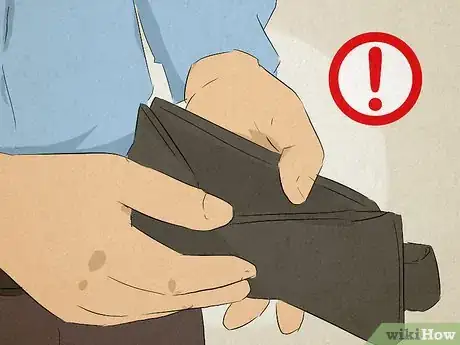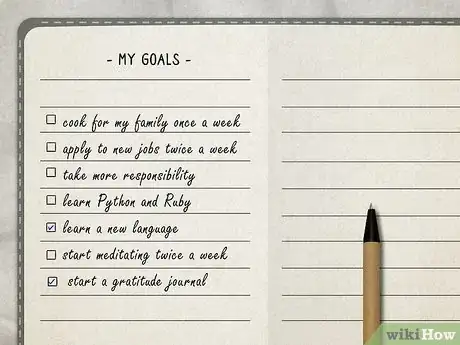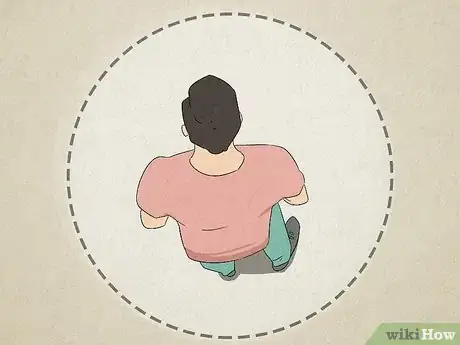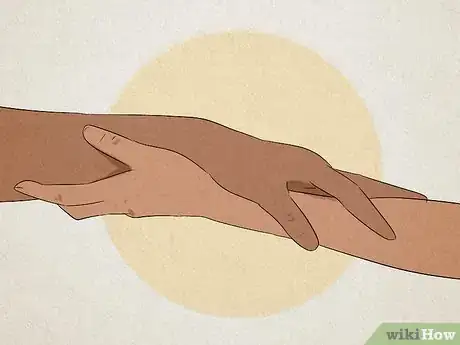This article was co-authored by Annie Lin, MBA. Annie Lin is the founder of New York Life Coaching, a life and career coaching service based in Manhattan. Her holistic approach, combining elements from both Eastern and Western wisdom traditions, has made her a highly sought-after personal coach. Annie’s work has been featured in Elle Magazine, NBC News, New York Magazine, and BBC World News. She holds an MBA degree from Oxford Brookes University. Annie is also the founder of the New York Life Coaching Institute which offers a comprehensive life coach certification program. Learn more: https://newyorklifecoaching.com
There are 10 references cited in this article, which can be found at the bottom of the page.
This article has been viewed 43,993 times.
Some habits form out of repetition and routine. Other habits form as a way of avoiding unwanted (but often necessary) activities. Whether you've decided to make personal change a New Years resolution, or simply want to change up your day-to-day routine, changing a habit can be the start of a meaningful personal transformation.
Steps
Preparing for Change
-
1Recognize your undesirable habit. Before you can actually change any aspect of yourself, you'll need to acknowledge that something needs to change and identify the habit you wish to break. Perhaps someone has told you that you're doing something upsetting, or maybe you've simply recognized already that one of your habits is affecting your wellbeing in some way. Whatever your situation might be, identifying what isn't working well in your life is the first step towards change.[1]
- Think about all the undesirable situations currently in your life. Do you suffer from money problems? Health issues like obesity or smoker's cough? Hygienic problems? Give yourself an honest assessment and identify areas of your life that are causing you problems.
- Once you've identified the undesired situations in your life, take a step back and analyze your behavior and your actions to determine what you're doing that is causing/creating those situations. Are your money problems caused by compulsive shopping? Perhaps weight problems are caused by poor diet or lack of exercise? A smoker's cough is undeniably caused by smoking, which may lead to money problems as well.
- Most undesirable habits fall into one of three categories: habits of the mind (such as thinking negative thoughts about yourself), habits of consumption (like overeating or smoking cigarettes), and habits of behavior (such as anxious nail biting, or biting lips and cheeks). Recognizing where your habit falls on this spectrum can help you identify other factors, like when and why you engage in that behavior.
-
2Determine your motivating factors. Now that you recognize what it is that's causing your problems, think about why you engage in that behavior. Every habit gives you something that you enjoy, even if that "reward" is simply avoiding something unpleasant that you don't want to do. Think about why you continue to engage in your undesirable habit, even though you recognize that it is causing you problems.[2]
- Some of the most common reasons for bad habits are attention, pleasure/gratification, excitement, comfort/validation, avoidance, and lack of consequences.
- Are your bad behaviors reinforced by others, or just by your own needs?
- Think about why your motivators (like attention, validation, etc.) are important to you. What do you get out of feeling that way?[3]
Advertisement -
3Identify your triggers. Sometimes recognizing your motivation will help you recognize your triggers. For example, you might be seeking excitement because of boredom, or seeking pleasure/gratification because you're stressed out. But other times your triggers might be less obvious. Before you can actually break your habit, you'll need to learn to recognize situations and scenarios that tend to precede your undesirable behavior.[4]
- Train your mind to become more aware of your mood and your thoughts/feelings immediately before you engage in the bad habit.
-
4Commit to change. Studies show that commitment to change is a vital part of the transformation process. Without deep personal commitment, most people cannot change themselves or their habits.[5]
- You may be able to get support from friends/relatives, but you'll need to believe in yourself first and foremost.
- Making the commitment to transform your own behavior will help motivate you to work hard and break your undesirable habits.
Breaking Your Habits
-
1Set SMART goals. In order for you to succeed, you'll need to create goals that are specific and attainable. Many experts recommend that when you create goals for yourself, you should follow the guidelines of S.M.A.R.T. goals: Specific, Measurable, Achievable, Results-focused, and Time-bound.[6]
- Specific - your goals should be clearly defined and should identify the what, why, and how of your transformation. For example, a specific goal here might be "I want to stop biting my nails whenever I'm nervous, and I will do this by replacing my nail-biting habit with a gum-chewing habit."
- Measurable - you should define goals that are quantified with tangible evidence. The best way to create measurable goals is by building several short-term or "minor" goals into your plan as a path of progress towards your ultimate goal. For example, when trying to stop biting your nails, decide that each week you'll stop biting your nails in increasingly-stressful situations. Start at home, then when you're traveling to work, then while you're at work, and after that you will kick the habit entirely.
- Achievable - your goals should challenge you somewhat, but they should ultimately be goals that you have the knowledge and skills to achieve.
- Results-focused - your goals should be measured by outcomes, not activities. In other words, you'll know you've met your goal when you've accomplished something (such as breaking your bad habit, or going a prolonged period of time without engaging in it).
- Time-bound - your goal should be built around a set frame of time in which you will work towards and ultimately achieve the end result. For example, decide that by the end of the first month, you'll have stopped biting your nails at home, by the second month you'll have stopped doing it while commuting, and so forth.
-
2Write out your goals. Studies have shown that writing out your goals can help you stay on track and provide additional motivation on your path to transformation. You may even want to keep a written copy of your goals posted in a place you will see everyday when you wake up. Then write your milestones on a calendar so you will know how much time is left before you should have completed some part of your process.[7]
-
3Put barriers in place. Sometimes it may be incredibly difficult to stop yourself from falling back into your old habit. One of the best ways to prevent this from happening is to self-impose barriers that will make it difficult for you to revert back to your old behavioral habits.
- If you are trying to break a behavioral habit, you might try making it unpleasant or otherwise difficult to engage in that habit. This could mean avoiding the thing you want to stop doing, or it could mean modifying some aspect of the behavior to make it undesirable.
- Say, for example, you're trying to stop chewing your pen cap. You could make all of your pen caps less appealing by applying a safe, unpleasant-tasting flavor extract on all of your pens. That way if you do find yourself mindlessly putting the pen in your mouth, the taste will correct that habit almost immediately.
-
4Distract yourself. Distractions are not necessarily helpful in the long-term, as continued distractions help cover for whatever it is you're avoiding. But when you're first starting out on the road towards personal transformation, distractions can help you avoid engaging in your bad habit by keeping your mind and body occupied with something else.[8]
- Healthy, productive distractions should be constructive, not destructive.
- A healthy distraction should require your full attention.[9]
- Instead of giving in to the craving for your habit, try talking to a friend or journaling about why you engage in that habit. It will keep you engaged and prevent you from dwelling on how great it might temporarily feel to revert back to your habit.
-
5Expose whatever you're covering for. Many habits develop as a way of coping with unpleasant emotions or situations. For example, you might develop a habit of overeating because it is comforting when you are sad or stressed. Another possibility is that you may have developed a habit of self-doubt to avoid challenging yourself in unfamiliar situations. Whatever your habit is helping you avoid, challenge yourself to be exposed to that emotion or situation without the aid of your habit.[10]
- Push yourself in small increments. Expose yourself a little at a time, perhaps having a trusted friend with you at first until you become comfortable. Then, little by little, expose yourself to your source of stress in increasingly-longer sessions until you can experience whatever it is you feared alone and for prolonged periods.
Making a Lasting Change
-
1Replace bad habits with good ones. Many people find it difficult to kick a long-term habit because the body and brain become accustomed to engaging in that activity. That's why many former smokers continue to have oral fixations (like chewing on a toothpick) long after they quit.[11]
- Changing yourself for the better is a two-part process. Getting rid of a bad habit comes first, but staying away from that habit in the future requires you to find a new habit to replace it.
-
2Develop a keystone habit. The best new habit to develop is what experts call a keystone habit. This is the one habit that breaks all the other undesirable patterns in your life. For example, if you're trying to lose weight, developing a daily exercise regimen can motivate you to eat better, be more productive, and think more positively about yourself.[12]
- Keystone habits give you a sense of satisfaction from a series of small, minor victories. It should be something that gives you immediate results, and it should be manageable no matter what level of change you're at.
- Good keystone habits rely on a cue and a subsequent reward in order to be successful long term. For example, if you are trying to check your email less often, your cue might be to start working for an uninterrupted length of time beginning at the top of the hour, and if you succeed you can allow yourself to check your email (reward).
-
3Accept support. Some people may find that self-motivation is sufficient, and ultimately the goal is to be able to keep yourself motivated and committed. But as stressful situations arise, you might find that your own motivation is not enough to keep you from reverting back to bad habits. One way to help ensure success on your road to transformation is to let your friends/relatives know that you're trying to break a bad habit, and ask them for their support.[13]
- Accepting support doesn't just mean learning to receive the support of others. It also means learning to support yourself. It may be very difficult for you to believe in yourself, but working to do so everyday will help you on the road to making permanent changes.
- Learn to celebrate small victories. If you reach a milestone on the way to accomplishing your larger goals, take the time to feel good about your progress. Reward yourself with some kind of healthy treat, but don't use your success as an excuse to indulge in whatever bad habit you're in the process of breaking.[14]
-
4Avoid temptation. Many bad habits become a recurring issue when you are faced with temptation. No matter how strong your will and your commitment to change, being around whatever you used to engage in could cause you to revert back to that habit. No matter how far along in your attempt to change, it's best to completely avoid any temptations that could cause you to falter.[15]
- If you're trying to continue eating healthy, don't keep fatty junk food in your house. If you're trying to stay away from cigarettes, don't keep a pack lying around your apartment. Purge yourself of anything that could cause you to pick up your old habit again, and stay away from situations that might tempt you.
Habit Breaking Journal Entry Template
Warnings
- While these steps can work for many habits, some habits may actually be addictions. If you have a habit that may be bordering on addiction, talk to a qualified medical professional who can help you develop healthier strategies for these behaviors.⧼thumbs_response⧽
References
- ↑ http://www.webmd.com/balance/features/3-easy-steps-to-breaking-bad-habits
- ↑ https://www.psychologytoday.com/blog/fulfillment-any-age/201108/5-steps-breaking-bad-habits
- ↑ http://psychcentral.com/lib/7-steps-to-changing-a-bad-habit/
- ↑ https://www.psychologytoday.com/blog/the-modern-time-crunch/201401/plan-breaking-those-bad-habits
- ↑ https://www.psychologytoday.com/blog/fulfillment-any-age/201108/5-steps-breaking-bad-habits
- ↑ http://www.hr.virginia.edu/uploads/documents/media/Writing_SMART_Goals.pdf
- ↑ https://www.psychologytoday.com/blog/the-intelligent-divorce/201312/break-bad-habits
- ↑ https://www.psychologytoday.com/blog/science-and-sensibility/201508/how-start-breaking-your-worst-habit-today
- ↑ https://www.psychologytoday.com/blog/where-science-meets-the-steps/201404/what-is-healthy-distraction
- ↑ https://www.psychologytoday.com/blog/science-and-sensibility/201508/how-start-breaking-your-worst-habit-today
- ↑ https://www.nlm.nih.gov/medlineplus/magazine/issues/spring12/articles/spring12pg18-19.html
- ↑ https://www.psychologytoday.com/articles/201203/earnings-and-yearnings-get-out-the-groove
- ↑ https://www.psychologytoday.com/blog/the-intelligent-divorce/201312/break-bad-habits
- ↑ https://www.nlm.nih.gov/medlineplus/magazine/issues/spring12/articles/spring12pg18-19.html
- ↑ https://www.nlm.nih.gov/medlineplus/magazine/issues/spring12/articles/spring12pg18-19.html
About This Article
Changing a habit can be quite challenging, but you can start by setting a specific goal that identifies what you’re doing, why you’re doing it, and how to go about changing it. If you bite your nails, for example, your goal may be “I want to stop biting my nails whenever I’m nervous. I’ll do this by replacing my nail biting with gum chewing.” Make sure to write your goal on a piece of paper and place it where you’ll see it every day, which will help you stay on track. Set a reasonable deadline for making significant progress, like giving yourself 1 month to no longer bite your nails at home. Then, give yourself the second month to stop biting your nails at work, and so forth, until you gradually eliminate the habit in all areas of your life. For more advice from our co-author, including how to avoid temptations when you’re trying to break a habit, keep reading.


















-Step-16-Version-4.webp)





















































